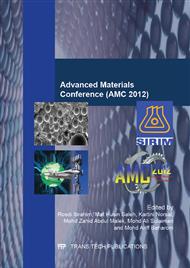[1]
German, R.M. (2005). Powder Metallurgy and Particulate Material Processing, Metal Powder Industries Federation, Princeton. (2005) 2-5.
Google Scholar
[2]
German, R.M. Powder, binders and feedstock for powder injection moulding. Powder Injection Moulding International, 1(1), (2007) 34-39.
DOI: 10.1016/s0026-0657(01)80592-0
Google Scholar
[3]
Omar, M.A., Ibrahim, R., Sidik, M.I., Mustapha, M., & Mohamad, M. Rapid debinding of 316L stainless steel injection moulding component. J. of Mat. Proc. Tech., 140, (2003) 397-400.
DOI: 10.1016/s0924-0136(03)00772-6
Google Scholar
[4]
Cheng, H.J., Hsiau, S.S., Liao, C.C. Influence of the interaction between binder and powders on melt agglomeration behavior in a high-shear mixer. Powder Technology 211, (2011) 165-175.
DOI: 10.1016/j.powtec.2011.04.014
Google Scholar
[5]
Hsu, K.C., Lin, C.C., & Lo, G.M. The effect of wax composition on the injection moulding of carbonyl iron powder with LDPE. Canadian Metallurgical Quartely, Vol 35(2), (1996) 181-187.
DOI: 10.1179/cmq.1996.35.2.181
Google Scholar
[6]
Lin, S.T. & German, R.M. Interaction between binder and powder in injection moulding of alumina. J. Mat. Science 29, (1994) 5207-5212.
DOI: 10.1007/bf01151118
Google Scholar
[7]
Simons, S.J.R., and Fairbrother, R.J. Direct observation of liquid binder-particle interactions: the role of wetting bahaviour in agglomerate growth. Powder Technology 110, (2000) 44-58.
DOI: 10.1016/s0032-5910(99)00267-3
Google Scholar
[8]
Hancock, B.C., York, P. and Rowe, R.C. An assessment of substrate-binder interactions in model wet masses. 1: Mixer torque rheometry. International Journal of Pharmaceutics 102, (1994) 167-176.
DOI: 10.1016/0378-5173(94)90052-3
Google Scholar
[9]
Istikamah Subuki Injection Moulding of 316L Stainless Steel Powder Using Plam Stearin Based Binder System. (PhD Eng. Thesis, Universiti Teknologi MARA) (2010) 66-76.
Google Scholar
[10]
Yi-min, L., Xiang-quan, L., Feng-hua, L., Jian-ling, Y. Effect of surfactant on properties of MIM feedstock. Trans. Nonferrous Met. Soc China 17, (2007) 1-8.
Google Scholar
[11]
Liu, L., Loh, N.H., Tay, B.Y., Tor, S.B., Murakoshi, Y., & Maeda, R. Mixing and characterisation of 316L stainless steel feedstock for micro powder injection molding. Material Characterization, 54, (2005) 230-238.
DOI: 10.1016/j.matchar.2004.11.014
Google Scholar
[12]
Moballegh, L., Morshedian, J., & Esfandeh, M. Copper injection molding using a thermoplastic binder based on paraffin wax. Materials Letters, 59, (2005) 2832-2837.
DOI: 10.1016/j.matlet.2005.04.027
Google Scholar


